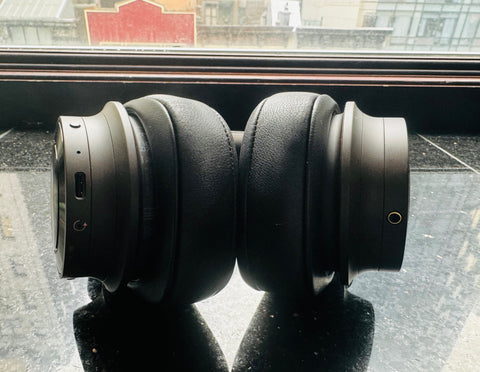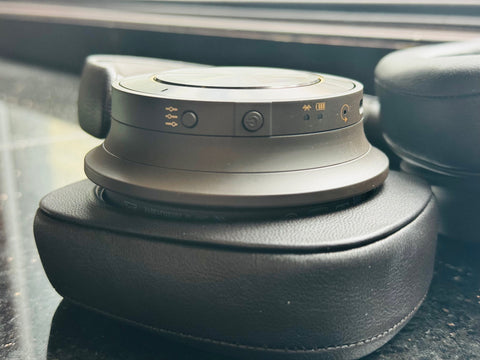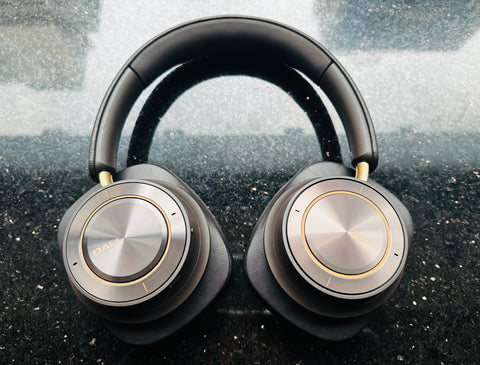Dali has always been an appealing niche headphone to me, given it’s incredibly clean and distinctive paper-coney sound. But this is Dali's highest performing headphone to date. What improvements has the company come up with? And can the iO-12 compete with wireless cans from luxury brands, like Focal and Mark Levinson? Let’s take a look at what you can expect in terms of performance and tuning.
In the Box
- USB-C charging cable (also works as audio cable)
- 2 3.5 mm stereo cable (different lengths)
- 3.5 mm to 6.3 mm adapter
- Flight adaptor
- Damn fancy travel case
Look and Feel
These cans are big, specifically, the massive square-shaped ear pads that cover the entire surface area around the ears with room to spare. In fact, it might make your head look like a raisin. But while the appearance may seem a tad bulky (though admittedly classy in its solidity and high-end build), the ear pads offer one of the most snug and comfortable fits I’ve tried. In fact, your head feels completely swaddled by the somewhat firm clamping force and plush, forgiving leather padding. And although the headphones have some weight to them, they never felt cumbersome on my head. They make for great ear muffs in the winter too.


Design
The iO-12 incorporates patented SMC technology in the 50 mm driver magnet system, a unique feature that’s the first of its kind with respect to their headphones. This, in conjunction with Dali’s distinctive paper fibre cones, aims to achieve realism and eliminate distortion. With the iO-12, the Company has strived to replicate the low-loss sound, unbeatable resolution, and dynamic capabilities characteristic of Dali speakers. In essence, they are positioned as true Hi-Fi speakers designed for private listening. We’ll see if they have succeeded.
Finally, I always like to mention volume levels in my wireless reviews, because there is often very little headroom on Bluetooth headphones. But the iO-12 provides enough sonic juice with room to spare.
Controls
All the features of the headphone can be activated by the buttons on the side ear cup as well as via the touch controls/buttons on the face of the ear cup. You’ll be able to switch between bass mode and hi-fi mode, as well as control the ANC and navigate through tracks and phone calls. Interestingly, there is no accompanying app for the iO-12, so you won’t have any equalizer control or added features that often come standard with other leading wireless headphones. But honestly, these cans sound so good that I would never tinker with the equalizer anyway.

Noise Cancelling
I found the ANC to be very effective, though this may not be the iO-12’s stand out feature. But like most other best-selling ANC headphones, the iO-12 did a good job of eliminating low rumbles and other minor ambient disturbances. In addition to ANC mode, you also have a transparent mode that invites in sound from the outside environment for greater awareness.
Bluetooth
The IO-12 employs Bluetooth version 5.2. Pairing was super fast and easy, and I never experienced any dropouts even when in a busy city setting.
With respect to supported codecs, you’ve got aptX, aptX HD, and aptX Adaptive, which is the latest aptX codec to hit the market.
Battery
The iO-12 delivers 35 hours of battery life, which is sufficient in my books, but still only average for a headphone of this caliber.

Sound Impressions
Soundstage
It’s easy to call a headphone immersive, but this is particularly true for the Dali iO-12. In terms of height, you’ll feel vast separations between lower and higher-placed instruments. Elements can sit super low compared to higher positioned instruments, creating a dynamic contrast and palpable sense of height. While you will get a decent sense of depth, the imaging along this axis sometimes leans into the stereo field, which is impressively wide as well. In fact, the stereo field is where the wow factor happens. Although it’s not stadium-like in its expansiveness, the placement is exceptionally accurate, peppering instruments across the canvas with the tiniest degrees of precision. The remarkable level of separation also helps the soundstage, creating a greater sense of color and distance between elements. And the result is a thoroughly multidimensional and entertainingly vibrant sonic experience. Does the stage approximate what you would get from hi-fi speakers? Almost, but perhaps not as open sounding.
Low-End
With the extra bass setting turned off, the bass is tight, fast and sometimes modest in its presence compared to the bass heavy profiles that characterize so many other wireless cans. That said, the bass never felt lacking. The iO-23 still provided ample punch, but the presentation was relatively uncolored. Once the extra bass is turned on, you can expect a fatter and warmer delivery with darker tonal qualities. This proved especially useful when I was switching between genres; while I enjoyed the added impact of the bass on modern tracks, it was helpful to switch it off on classical tracks so that instruments were leaner and unsaturated, thereby conveying a more life-like timbre. And here, it should be noted just how realistic the presentation is. String instruments for example, show an incredible amount of transparency and resolve for a wireless headphone. Subtle textures and timbral details were revealed, enhancing both, the depth and character of the performance.
Mids
This range provides an addictive balance that gives plenty of love to the low-mids without removing any impact and snap that comes from a slightly forward upper-midrange. The layering is impeccably clean in this range, providing ample definition between instruments, especially as the presentation becomes a bit thinner in upper mids. And even in the lower midrange, where elements can potentially get cloudy, the separation within singular instruments, like guitars, is immaculate. What’s also striking is how versatile this sound signature is. Pop music sounds excitingly energetic, while intimate acoustic tracks feel delicate and intricate in their delivery.
Highs
Plenty of sparkle and radiance up here. There’s a refreshing brightness to the treble that rarely becomes fatiguing. And any treble peaks feel relatively smooth, though a few exceptions occurred when playing high-pitched brass, for example. Vocals are especially delicious in this range, offering an elegant balance between smoothness and detail. It’s both, velvety and airy, providing depth and buoyancy at once.
Summary
The iO-12 is probably the most skilled and most enjoyable sounding wireless headphone on the market right now. With a versatile bass, comprehensive mids, and luminous highs, there’s no genre that this headphone can’t handle. Add to that an immaculately clean and detailed profile, and you’ve got a flawless sound signature that becomes more addictive the longer you listen to it. The price tag may be stiff, but when you compare the iO-12 to other wireless cans in the same echelon, you realize that it’s completely worth it. In fact, you might be left wondering whether you need any wired headphones at all.
You can buy the Dali iO-12 at Audio 46.


 FREE Shipping
FREE Shipping




